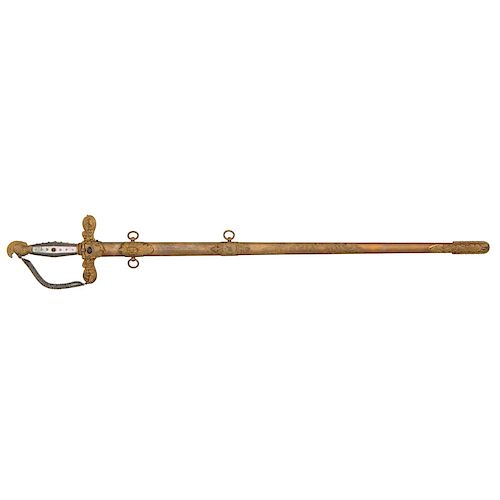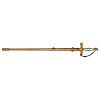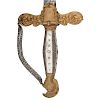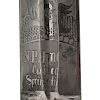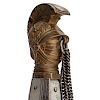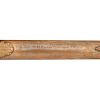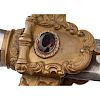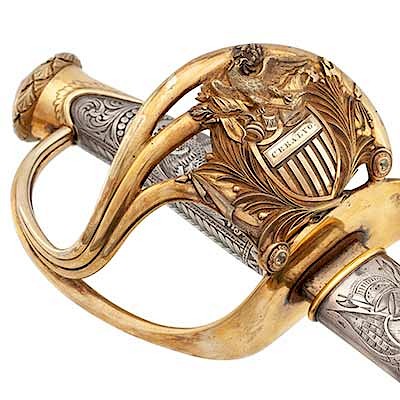Mexican War Presentation Sword of Lt. William H. French by Hyde & Goodrich
About Seller
6270 Este Ave.
Cincinnati , OH 45232
United States
With offices in Cincinnati, Cleveland and Denver, Cowan’s holds over 40 auctions each year, with annual sales exceeding $16M. We reach buyers around the globe, and take pride in our reputation for integrity, customer service and great results. A full-service house, Cowan’s Auctions specializes in Am...Read more
Two ways to bid:
- Leave a max absentee bid and the platform will bid on your behalf up to your maximum bid during the live auction.
- Bid live during the auction and your bids will be submitted real-time to the auctioneer.
Bid Increments
| Price | Bid Increment |
|---|---|
| $0 | $25 |
| $500 | $50 |
| $1,000 | $100 |
| $2,000 | $250 |
| $5,000 | $500 |
| $10,000 | $1,000 |
| $20,000 | $2,500 |
| $50,000 | $5,000 |
| $100,000 | $10,000 |
About Auction
Oct 30, 2018
Cowan's is honored to present the Magnificent Sword Collection of William Koch in its two-day firearms, militaria, and American history auction, with a focus on the Civil War. Cowan's Auctions dawnie@cowans.com
- Lot Description
Mexican War Presentation Sword of Lt. William H. French by Hyde & Goodrich
31.25" double-edged, straight spear-point blade with nearly full-length, narrow median fuller. 6.25" gilt brass hilt with knight's head pommel and 5.625" cross guard cast in the form of flowing feathery sprays with a pair of similarly theme languets. Octagonal grip alternates mother of pearl scales and engraved silver strips with flowing foliate sprays, with silver studs in the mother-of-pearl and a single 6mm x 8mm garnet in the center of the obverse grip panel. A matching emerald cut garnet measuring 13mm x 10mm is present in the center of the obverse languet. A double chain knuckle guard is secured to a ring below the visor of the knight's helmet and the end of the lower quillon. Frostily etched blade with flowing foliate scrolls and martial themes including panoplies of arms on both sides and with an American eagle on the reverse. Obverse ricasso is etched in three lines: N.P. Ames / Cutler / Springfield . The gilt brass scabbard is profusely engraved on the obverse with martial and foliate themes, while the reverse throat is engraved: Hyde & Goodrich / New Orleans / BY / N.P. AMES / Cabotville / MASS . Between the upper mounts on the obverse of the scabbard, the following inscription is engraved: Presented to / LIEUT. W.H. FRENCH 1st. ARTILLERY U.S.A. / ASSISTANT COMMISSARY of SUBSISTANCE / at BRAZOS ISLAND DEPOT. By his CLERKS / FEB. 7, 1847 . Mounts are profusely detailed oak leaf clusters, with a frog button and two suspension rings on the upper mount and a single ring on the middle mount. A very attractive Mexican War presentation sword that was actually presented at the height of the war, almost exactly a year before its conclusion.
Born in Baltimore January 13, 1815, William H. French graduated West Point ranking twenty-two of fifty in the Class of 1837 that boasted a number of future Civil War notables including Hooker and Sedgwick and with the South, Bragg, Early and Pemberton. French was duly commissioned 2nd lieutenant in the elite 1st Artillery having chosen a military career amidst the austerity of the Jacksonian era. Nine companies of the 1st Artillery would serve in Florida during the Seminole War in 1837-38, best described as "a barren warfare, marches without battles, scouting by day, alarms at night"...boredom. Detached and scattered among various temporary enclosures by company, the regiment collectively saw only moderate action in fewer than a dozen or so smaller skirmishes with an illusive enemy. On July 1, 1838, French was promoted to 1st lieutenant and joined a detachment in the forcible removal of the Cherokee people along the Trail of Tears to Oklahoma. It is not recorded what French thought of this onerous duty. Later in 1838 Lieutenant French was posted to Ft. Covington, NY, and then between 1840-1843 to the frontier separating Maine and New Brunswick during the unresolved border disturbances with Crown authorities in Canada. A crisis with Britain adverted, nonetheless the regiment remained concentrated in upper New England until the Northeastern Bounty Survey rectified the boundary dispute. With the advent of war with Mexico the 1st Artillery sent 4 companies directly to Zachary Taylor's Army of Occupation in Texas with six more going to Florida. Many regular officers bound for the front found themselves temporarily detached from their units and assigned to support functions. The unprecedented buildup of Taylor's army required dedicated staff to manage and stage the wealth of supplies and equipment that would catapult the advance into Mexico. Credit is due the army Quartermaster General (Jessup) for quickly realizing that it would be impossible to sustain an invading army with the old Napoleonic maxim of living off the land. Mexico was too poor with little in the way of infrastructure. Before General Taylor marched southward to Fort Texas he had to secure a base of logistics necessary for sustained operations beyond the Rio Grande. The importance of this was underscored when General Taylor took leave of the army and traveled back to Point Isabel to discuss procedures for processing incoming goods, materials, supplies, and troops with naval authorities who would convey these commodities from the main supply hub at New Orleans. It was agreed that, henceforward, men and cargo would bypass Point Isabel entirely. Instead, everything required by the army would be delivered to the Brazos Island already secured by the navy. From the main depot on Brazos Island stores could be easily transported to camps along the Rio Grande and then to Matamoras for transshipment to the army in the field. Lieutenant French was put "in charge of the Commissary Depot at Brazos Island" (according to Cullum's Register ) in 1846 without which further operations in Northern Mexico would have been untenable. The array of anonymous "clerks" on the presentation were likely civilian storekeepers employed by the army who evidently held the commanding officer in high esteem. Lieutenant French served in the same capacity at the depot at Point Isabel early in 1847 and may have alternated between both supply points.
Shortly after receiving this presentation sword in February 1847 Lieutenant French was relieved from temporary duty and returned to field operations with Winfield Scott's Army of Invasion. French's' regiment was serving as infantry in General David Twiggs' regular division while French himself was assigned to the staff - as Scott's eyes and ears - of Major General Robert Patterson, a former regular officer now commanding the volunteer division as Acting Assistant Adjutant General. French was engaged in Scott's month long siege of Vera Cruz which finally fell on March 29, 1847 Scott advanced toward Mexico City and reached Cerro Gordo on April 12 where Santa Anna had roughly12,000 men arrayed in extensive defensive fortifications supported by artillery. American engineers quickly surveyed the terrain and determined possession of the Atalaya Hill would allow the army to flank the Mexican extended positions. The engineers went to work and for five days literally excavated a circuitous route for the assaulting troops. Twiggs' regulars attacked and took the hill late on the 17th advancing up the slopes to a redoubt called the El Telegrafo. Early the next day one of Twiggs' brigades resumed the attack up the front while another brigade attacked from the rear. By 10:00am El Telegrafo was in American hands as was the Mexican camp on the Jalapa Road. Mexican troops either surrendered (about 3,000) or fled precipitously with Santa Anna leaving his wooden leg to be captured by Illinois volunteers. Lieutenant French was brevetted to captain on April 18 for "gallant and meritorious conduct" during the fight. Captain French would receive another brevet to major for gallantry at the battles of Contreras and Churubusco on August 19-20, 1847. Santa Anna defended the approaches to Mexico City with upwards of 30,000 men including 7,000 under General Gabriel Valencia with 22 guns located near Contreras. At first, the American brigades deployed planning to flank Valencia's position, but maneuvering caused the avenue of attack to spread out as the various units sought, at several points, to pin the Mexican's in place. Santa Anna sent reinforcements but nightfall and rain put an end to the day's fighting. A chance discovery that night of a hidden ravine than ran into the rear of Valencia's camp dictated the American plan for the morning. The American's put in a two pronged attack before dawn, front and back, that quickly put Valencia to flight. The Mexicans fell back to Churubusco less than five miles from Mexico City where the fighting would continue the next day. Santa Anna concentrated fewer than 4,000 defenders around the Franciscan Convent at Churubusco and a subsidiary defensive feature known as the tete-de-pont. For once the American army of 8,500 outnumbered the Mexicans defenders. Scott sought to outflank the position and the lead American brigade ventured an attack than captured a number of Mexican guns causing the supporting troops to withdraw. Seizing upon the moment Scott then ordered a general attack. Twiggs' division would the convent directly while Worth's division would envelop the tet-de-pont. Despite heroic Mexican resistance the American victory was complete. More than 1,800 Mexicans were captured together with ten pieces of artillery. Among the captured were 72 men of San Patricios Battalion, a unit of former American soldiers, Irish born Catholics, who had deserted. Fifty of the men were court-martialed and summarily hung in retribution while the remainder were given fifty lashes. Winfield Scott then demonstrated a measure of magnanimity refusing to pursue the beaten Santa Anna into the capital, " willing to leave something to this republic...I halted our victorious corps at the gates of the city. " At the secession of hostilities Major French remained in Mexico until the end of the year as Aide-de-Camp to volunteer Brigadier General (and future President) Franklin Pierce.
Two rings further up the promotion ladder, Major French returned to garrison duty at Fort McHenry later in 1848. His service in the decade before the Civil War was fairly routine by army standards. He spent another two years in Florida subduing the last of the Creek-Seminole holdouts and authored a treatise on Light Artillery Tactics that would be adopted by the army. The later exploits of William Henry French are certainly known to students of the Army of the Potomac. French was promoted to brigadier general of volunteers in September 1861 and led a brigade in the 2nd Corps during the Peninsula Campaign and then a division at bloody Antietam. French's' conduct, if not entirely exemplary, did not go unnoticed as he added two more regular brevets - lieutenant colonel for Fair Oaks and colonel for Antietam - to his record. All of this was capped by a second star to major general on November 29, 1862. French fought at Fredericksburg and Chancellorsville and would be brevetted again (to brigadier general) for the latter in March 1865. Major General French sat out Gettysburg being sidelined at Harper's Ferry, but Sickles' wound at Gettysburg created a vacancy at the top of the broken 3rd Corps which French stepped in to. General French's otherwise impressive army career was to be completely unhinged by the tardiness of his 3rd Corps during the Mine Run Campaign in November 1863. Perhaps to mitigate the sting of public rebuke, French was advanced to lieutenant colonel, regular army, on February 8, 1864. Not availing of coincidence, when the Army of the Potomac was reorganized for Grant's Overland Campaign in the spring of 1864, the 3rd Corps was dissolved, and Major General French mustered out of volunteer service on May 6, 1864. French retained his seniority in the regular army and added a sixth career brevet promotion to major general, this in the multitude of promotions given in March 1865. The intrepid French remained in the army for another fifteen years being promoted to regular colonel, 4th Artillery on July 2, 1877 before retiring at his own request on July 1, 1880. The idle officer did not last long in retirement. General French died on May 20, 1881 in Washington, D.C. and is buried in the Rock Creek Cemetery there. Having achieved the rank of volunteer major general interspersed with six brevet promotions, French was held in higher regard in his own day than by modern historians, to whom he remains largely unheralded.
Provenance: From the Sword Collection of William KochFine. Blade retains nearly all of its bright polish and frosty etching, with a few scattered flecks of surface oxidation and pinpricking, along with a thumb sized area of minor pitting on the obverse near the tip. Hilt fine, retaining some traces of gilt finish, with a couple of the silver strips in the grip slightly loose and some minor light handling marks. Scabbard fine, with traces of gilt in protected areas, with a deep butterscotch patina. All engraving and the inscription remain clear and fully visible. Scabbard shows some scattered light handling marks and a couple of very tiny dings.Condition
- Shipping Info
-
Buyers are required to pay for all packing, shipping and insurance charges. Overseas duty charges are the responsibility of the successful Bidder. Be aware that for larger and/or valuable items, shipping charges can be substantial. - If there is no shipping amount on listed your invoice, you will need to make arrangements to pick up or ship your purchase through an alternative shipping company. Our shipping department can be contacted at 513.871.1670 (ext. 219) or email shipping@cowans.com. - Shipping charges include insurance for your order while in transit. If you have private insurance we will adjust your charge to include only packing and shipping. - Please allow 14 – 21 days after payment to package and ship your purchase as carefully as possible.
-
- Buyer's Premium



 EUR
EUR CAD
CAD AUD
AUD GBP
GBP MXN
MXN HKD
HKD CNY
CNY MYR
MYR SEK
SEK SGD
SGD CHF
CHF THB
THB